The Significance of Bonfire (Thee-Jwala Shushrusha) in Christmas Service
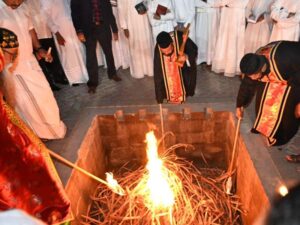
The Liturgy of Christmas (Yeldho Perunaal) is celebrated in the silence of night, often creating an inexplicable, incomprehensible experience of the coming down of heaven to earth, in the minds of the faithful. Prior to the Celebration of Holy Eucharist, there is a special service performed of a burning fire set in a Cruciform (cross-shaped) pit or in a container (some Churches, have a permanent covered pit). This Bonfire (Thee-Jwala Shushrusha) is conducted outside in the open space, at the west side of the Church. This spiritual bonfire is meaningful and biblically based and a spiritual event, as at His ‘Incarnation’ that, faithful happened in history once and for all. The people of all generation must get a chance to experience the birth of the Divine Light (Lord Jesus Christ) on earth.

The Procession
The procession starting from East to West and back around the Church, on the Christmas day is to remember and reflect the arrival of the shepherds and the wise men from the East, to where Christ lay in a house, guided by a bright shining star. Each faithful must identify himself/herself with the shepherds and the wise men who reached on foot, worshipped Him, and presented Him with gifts. On the day of the Incarnation of our Lord, the angels and heavenly hosts reached there as procession, chanting praises and praises to God. All these instances are to be visualised in the minds of the faithful as they would take part in the processions.
The Palm Leaves
The Malankara Indian Orthodox Church keeps the blessed palm leaves of Hosanna Sunday till Christmas, signifying the presence of Jesus Christ in our houses. This Palm leaves are burnt in a symbolic bonfire during the symbolize the burning away of all impurities (evil/sin). The bonfire symbolizes the fire that the shepherds of Bethlehem made in the cave where Christ was born. The warmth of the fire symbolises the salvation. The Palm leaves are no more needed as Jesus Christ is born to today into our houses and hearts. A tradition prevailed in early days, when our faithful used to take away the ash to spread in the paddy fields and other cultivation after the Christmas worship.
The Incense
We offer frankincense during this service chanting the angelic hymn, “As the angels and the archangels up in the heaven….” (Melpatta uyarangalil swargeeya malakhamaar sthuthikkunnathupole balaheenarum manmayarumaya njangalum sthuthichuparayunnu…). We are, in fact, offering ourselves and our gifts to our Lord and God Jesus Christ who was born for us in Bethlehem, the City of David like the poor shepherds and the Magi.
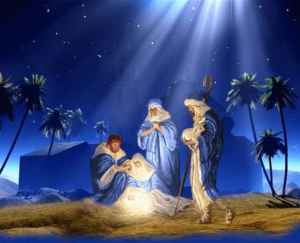
The Fire
This Bonfire re-lives, the remembrance of the night the shepherds heard the carol of Christ’s birth on a serene and silent night, 2000 years ago. When the shepherds and the wise men from the East who came to see baby Jesus in the manger at Bethlehem, they saw the very same Glory of the very same God, Who appeared before Moses at the burning bush which prompted them to worship Him together with the herald of angels (Matt. 2: 11, Lk. 2: 20). The fire is the representation of God’s presence. This very event endorses the divinity of Christ Jesus, which we too by way of this holy ritualistic service on Christmas, are given an opportunity in the present time to see the glory of God in the physical, mental and spiritual plane, for we are privileged to have access to Him (Gal. 4: 4-7).
The objects for making the bonfire are the blessed palms of previous years’ Hosannah festival, along with firewood. Fire’ is the ‘Seat of God’, the medium and symbol of the presence of God. For our God is a consuming fire (Heb. 12: 29). The flames that rise-up in darkness are a symbol of ‘The light is that which eradicates darkness. Light implies the divine, where as darkness, the evil.
There is a special meaning of the firewood, we use in the pit of fire, in addition to the dry palm leaves. There was a tradition to take out the parasites that attacked the trees (itthil Kanni) and dry them for use days before the Christmas. It has a symbolic meaning. The parasites destroying the trees and plants must be destroyed and likewise all parasites in our spiritual lives are also to be destroyed. This fire is not just a normal fire, but a holy fire, as we also serve incense going round the Cruciform Pit. It should be never forgotten, that the very purpose of the Incarnation of Jesus Christ, was aimed to give Himself as a sacrifice through Crucifixion. Jesus came to us in order to die – this was known by Him, from the very beginning. In Iconography, the manger in the Nativity Icon deliberately resembles a stone coffin, the swaddling clothes resemble a burial shroud, and the cave itself can even be said to prefigure Christ’s tomb. In Syrian tradition, the Holy Cross prefigures in all Maranaya Perunaals.
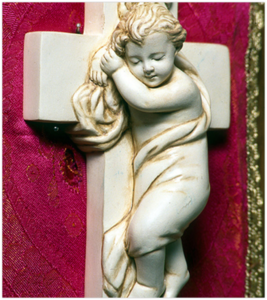
The Light from Fire
What was seen in Bethlehem was the Son of God, Who was the Light from Light, as prophesied by Isaiah, that at Incarnation that Light rose over people who were in darkness. “The people who sat in darkness saw a great light and upon those who sat in the region and shadow of death light has dawned.” (Is. 9: 2; Matt. 4: 16).The Great Dawn of Our Lord Jesus Christ illuminated all creation completely. The lighting up of bonfire on the feast of Yeldho is a symbol of the birth of our Saviour who is the Light of the World.”
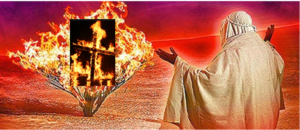
During the celebration of the Holy Cross the prayer states that “Let Your Light be dawned in us.” In the Sedro of the Matins, we pray “On the day of your Incarnation, Light was dawned on Your Creation and darkness was dispelled from all directions.” In the holy Bible, we see that God appears before Moses in the form of fire at the bush and as the flash of light on the Mount Sinai. (Ex. 3: 3-6; 19:16-20). The fire during Christmas liturgy signifies the flash of light and the burning bush, which Moses witnessed. This symbolically communicates to us, the glory and grandeur of God. The burning bush prefigures the Sleeba Tree (Maram), on which Jesus was Crucified.
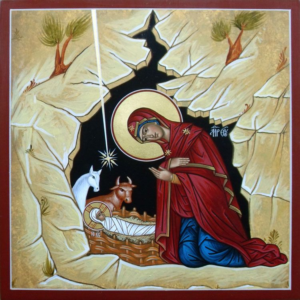
The Nicene Creed confesses Jesus Christ is “the Light of Light and very God of very God”.
4In him was life, and that life was the light of all mankind (Jn 1: 4). 9 The true light, which enlightens everyone, was coming into the world (Jn 1: 9).
35 Then Jesus told them, “You are going to have the light just a little while longer. Walk while you have the light, before darkness overtakes you. Whoever walks in the dark does not know where they are going. 36 Believe in the light while you have the light, so that you may become children of light” (Jn. 12: 35-37). 46 I have come as light into the world, so that everyone who believes in me should not remain in the darkness.(Jn. 12: 46).
2 And He was transfigured before them, and His face shone like the sun, and his clothes became dazzling white (Matt 17: 2). 23 And the city has no need of sun or moon to shine on it, for the glory of God is its light, and its lamp is the Lamb (Rev. 21: 23). 2wrapped in light as with a garment.You stretch out the heavens like a tent (Ps. 104: 2).
He reveals deep and hidden things; He knows what is in the darkness, and light dwells with Him (Dan 2: 22). 5 This is the message we have heard from him and declare to you: God is light; in him there is no darkness at all. 6 If we say that we have fellowship with him while we are walking in darkness…… (1 Jn. 1: 5-7).
For those who wholeheartedly partake in this rite in all faith, hope and love will certainly find the radiant face of our Savior Jesus Christ and this is the choicest for us faithful, to experience that spiritual event which happened some 2000 years ago. The Orthodox worship is a heavenly worship on earth.
May the One Holy Triune God, fill us today with the love and light of Christ that we may glow with the divine Light
0 Comments